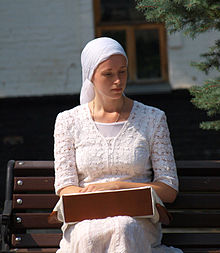Modest fashion

The term modest fashion or modest dressing refers to a fashion trend in women of wearing less skin-revealing clothes, especially in a way that satisfies their spiritual and stylistic requirements for reasons of faith, religion or personal preference.[1] The exact interpretation of 'modest' varies across cultures and countries. There is no unambiguous interpretation as it is influenced by socio-cultural characteristics of each country.[2] Beyond the various interpretations, all agree on the idea that modest fashion means loose clothing, comfortable dressing and covering of the body according to person's own comfort.
History
[edit]The term "modest" may have varied interpretations across religious boundaries and even within them. Commonalities can also exist; for example, many Christian, Jewish, and Muslim women practice the veiling of their head, with Christian women wearing a headcovering, Jewish women wearing a tichel, and Muslim women wearing a hijab.[3][4][1]
On 28 July 2015, a world panel discussion was held in Turin with the aim of defining guidelines for modest fashion.[5][6]
This growing phenomenon has been studied by scholars such as British professor Reina Lewis from London College of Fashion. Among her works on the topic we can mention 'Modest Fashion: Styling Bodies, Mediating Faith' (2013) and 'Muslim Fashion: Contemporary Style Cultures' (2015).[1][7]
In late 2018, modest fashion was considered a 250 billion dollar industry.[7]
Reception
[edit]Muslim and Jewish women have spoken of modest fashion as empowering.[8] “There’s a general misconception that modest clothing is inherently oppressive,” said Michelle Honig, an Orthodox Jewish fashion journalist and the keynote speaker during fashion month at New York University for the Meeting Through Modesty fashion symposium. “But if women in so-called ‘liberated countries’ still choose to cover their bodies, then they have made a choice. They have agency."[4]
However, some feminists have criticized modest fashion, considering it a "cynical" concept.[8] In 2019, after a modest fashion exhibition hosted in Frankfurt, Germany, Inge Bell from group Terre des Femmes stated that it was "a slap in the face of girls and women worldwide who don't want to wear the headscarf or want to take it off". A letter sent by activist to the Emma magazine called the exhibition an attack on both domestic and foreign women's rights activists, also emphasizing that "every year, thousands of women in Iran are punished for violating this dress code."[8]
Modest fashion across religions expresses consensus that it should not be experienced as a limiting factor in style. Brands are churning out designs and collections that an orthodox Muslim, Jew, Christian, Hindu can wear in style. Dolce & Gabbana, H&M, and Uniqlo are just a few names that have entered the modest fashion segment, making clothes that cover most parts of the body while allowing women to experiment with the latest trends.[when?]
In recent years, the acceptance of modest design has been gradually expanding and changing, mirroring a larger cultural movement toward diversity, inclusion, and personal expression in clothing. Modest fashion has gained popularity among a variety of customers, including those who follow dress standards related to their culture or religion and others who just want more conservative options. It emphasizes concealing the body while being attractive and fashionable.[9]
See also
[edit]References
[edit]- ^ a b c Adewunmi, Bim (16 June 2011). "Women Faith-based fashion takes off online". The Guardian. Retrieved 15 January 2019.
- ^ Ben, Hannes (19 April 2019). "Modest fashion, major opportunity". Locaria. Retrieved 4 March 2020.
- ^ Hunt, Margaret (11 June 2014). Women in Eighteenth Century Europe. Taylor & Francis. p. 58. ISBN 9781317883876.
- ^ a b Bauck, Whitney (1 November 2016). "What Does Modest Fashion Mean?". The New York Times. The New York Times. Retrieved 15 January 2019.
- ^ "DIEDC spotlights modest fashion in Italy". Gulftoday.ae. 2 August 2015. Archived from the original on 12 December 2017. Retrieved 30 December 2015.
- ^ "La storia di Wiwid: l'islamic fashion - Ti veste Liz! - MOOB Magazine". Moobmag.com (in Italian). 1 August 2015. Archived from the original on 8 August 2015. Retrieved 30 December 2015.
- ^ a b Adewunmi, Bim (5 November 2018). "Why The Modest Fashion Trend Isn't Going Anywhere". Buzz Feed News. Retrieved 15 January 2019.
- ^ a b c Binder, Antje; Grenier, Elizabeth (3 April 2019). "Muslim fashion for women exhibition stirs controversy in Germany". DW. Retrieved 15 September 2020.
- ^ "LAYANSI - Modest Fashion - Official Store". Retrieved 19 March 2024.
External links
[edit] Media related to Modest fashion at Wikimedia Commons
Media related to Modest fashion at Wikimedia Commons- Is Modest Fashion The Next Big Thing? - Forbes

